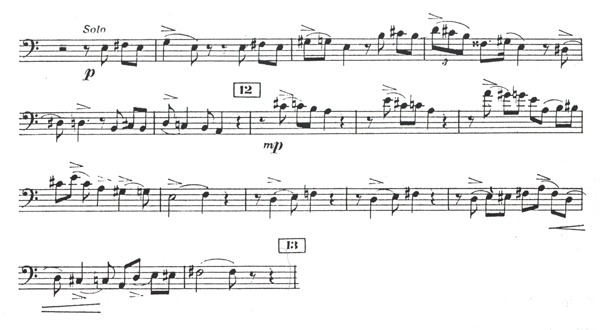The Importance of Wind Instruments to early 20th-Century French Composers
Editor’s note: Berlin Philharmonic Wind Quintet perform a program of wind pieces on February 9, 2013 in Hill Auditorium

Image: Score excerpt from Darius Milhaud’s La Création Du Monde.
It is easy, when listening to music, to become so enthralled with the serendipitous sound of the performers in front of us, or in our pockets, that we forget their instruments are pieces of technology that developed through time and experimentation. Of the instruments common to classical music, wind instruments represent the ‘youngest’ generation of devices conceived and constructed to produce new musical sounds.
Consider this: when legendary luthier Antonio Stadivari, whose violins continue to be played to this day, died in 1737, none of the instruments you will hear on February 9th’s Berlin Philharmonic Wind Quintet concert had been modernized. In fact, only the flute, of the other instruments on stage, can trace its direct ancestry so far back in time, with early method books for the transverse flute (which, at that time, were made of wood) appearing around the turn of the 18th-century.
Early forbearers of the modern oboe and clarinet emerge in the same century, drawing, as one would expect, the curiosity of the era’s leading composers. Mozart (an arrangement of whose Fantasy for Mechanical Organ is on the Berlin Philharmonic Wind Quintet’s program) possessed a famous fascination with the clarinet and wrote specifically for ensembles with access to these newly invented instruments. Over the course of the 19th century, we see brass instruments, like the French Horn, and the piano arrive at their modern forms, with integrations of these instruments, and others, into symphonic, opera and chamber settings.
Stravinsky’s Octet for Winds
Although instrument invention became far more experimental in the 1900s, we see composers – particularly French composers in the first few decades of the century – embrace the class of wind instruments, many of which had only recently been standardized, in their compositions. Although written earlier than the works of Darius Milhaud, Jacques Ibert and Francis Poulenc performed by the Berlin Philharmonic Wind Quintet, Stravinsky’s Octet for Winds (1922) and Milhaud’s La Création Du Monde (1923) are historically decisive works that prominently feature unconventional groupings of wind instruments.
Despite the fact that the genre and ensemble of the wind quintet has been present in classical music since the early 1800s, the works of Poulenc, Milhaud and Ibert featured on the upcoming concert provide further evidence of how important wind music was to early 20th century French composers’ definition of modernity. Additionally, Kalvi Aho’s Windquintet (2006) demonstrates the ensemble’s endurance as a music force, maintaining wind instruments’ sense of pertinence in the early stages of the 21st Century.
The Berlin Philharmonic Wind Quintet on the roof of the “Berliner Zeitung” building






